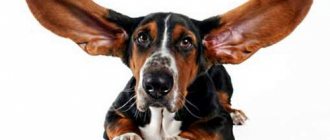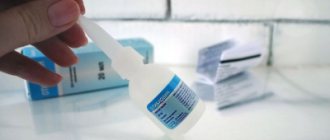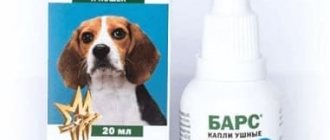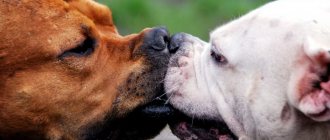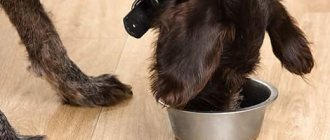22.09.2017
Hygiene practices such as cleaning your dog's ears are of utmost importance. Proper care prevents the occurrence of diseases at any age. Among all the necessary products, ear drops for dogs are among those medications that should be in every first aid kit. There are other products, such as cleansing wipes, antimicrobial sprays, ointments and lotions, that are very effective in caring for the ear. Ear drops for dogs are used not only in the treatment of diseases, but also as a preventive measure for otitis media and ear mites, which are very dangerous for your pet.
Ear drops and their features
Before choosing ear care products for your pet, you should familiarize yourself with the features of their use and the recommendations of each of them. These include:
- Ear drops for dogs in most cases contain diazinon, which in turn causes allergies in some pets.
- Used for the treatment and prevention of diseases such as ear mites, otitis media and scabies.
- Treatment must be carried out over a course of 5 to 7 days. It can be continued depending on the pet's condition.
- When using ear lotion for dogs, be careful to treat the inside of the shell to avoid damaging the eardrum. The procedure must be performed using a cotton pad or swab; under no circumstances should you use cotton swabs.
How to properly put drops in your dog's ears
The feeling of itching in a dog is sometimes so strong that it simply ceases to control its actions and can become quite aggressive.
Therefore, in order to correctly carry out the process of instilling drops, you must first calm the animal and establish the most trusting relationship with it. Some breeders advise swaddling the dog first so that it cannot escape at the most crucial moment, but there is absolutely no need to carry out this procedure. This is due to the fact that the animal will try to escape, which will also be marked by even greater aggressiveness.
It is recommended to drip the dog’s ear exclusively, reinforcing all your actions with affection and other trusting actions. A dog is an animal that has always been distinguished by its special intelligence and intelligence, therefore, if it understands that you are not doing any harm at all, but only want to do better by alleviating the pet’s condition, then it will independently allow such a manipulation as ear drops.
It is also necessary to take into account the fact that, according to the recommendations of veterinarians, drops can be instilled into an animal’s ear only after a preliminary complete cleansing process and elimination of purulent discharge.
Cleansing preparations and their types.
The most popular cleaning product is veterinary ear drops. They are produced in glass or plastic containers with a small volume dispenser. Be sure to be sealed. Designed for the treatment and prevention of ear diseases, and also prevents the occurrence of otodecosis. There are complex preparations, such as ear drops for Bars dogs. They contain not only the active substance, but also components for destroying bacteria and microbes, as well as additives that help relieve inflammation and heal wounds.
Ear drops for dogs with otitis media are used as the main treatment for the disease at all its stages. Otitis media causes unpleasant sensations and discomfort in the animal - it can nervously shake its head and constantly scratch its ears, tearing them until they bleed. It most often occurs in those breeds of dogs that have floppy ears. The drug relieves pain and itching sensations well. Used in a course of 5 days. The duration of treatment depends on the condition of the dog.
Ear ointment for dogs helps speed up the healing process for ear diseases. After cleaning the sink, ointment is applied to the surface. Treatment should be carried out over a course of up to 10 days; if necessary, it can be repeated up to 3 times. The ointment has a number of contraindications, for example sensitivity to the components. It is also not used for small puppies, pregnant or lactating bitches.
Ear lotion for dogs is used for hygiene procedures. It cannot be used as a remedy, since it does not contain active antifungal substances. It does not contain harmful additives and is therefore absolutely harmless to your pet. It has a pleasant smell and refreshes the ear for a long time.
In order to choose the right product, we recommend that you first become fully familiar with the assortment of the pet store, and then choose the most suitable product. We offer to purchase all the necessary products of the highest quality at the most affordable prices.
In our online store you can purchase the following products:
Ear drops for dogs for otitis media
Otitis media is a common disease in pets. Dogs with long drooping ears are especially susceptible to it.
To alleviate symptoms and get rid of the problem, there are many effective and proven remedies on the veterinary market.
Drops are available for:
- hygienic treatment of pet ears, suitable for regular use;
- fight against bacterial infections containing antibiotics;
- combating fungal infection, antifungal agents with miconazole, clotrimazole and nystatin;
- fight bacterial infection, relieve itching and inflammation;
- relieve allergic reactions, contain antihistamines and glucocorticoids;
- wound healing from injuries;
- getting rid of purulent bacterial otitis;
- to fight infection caused by ear mites, contain insecticidal components.
Drops are used for otitis and various infections
Surolan
Surolan drops of complex action for the treatment of bacterial, fungal and parasitic otitis media. They have good antipruritic and anti-inflammatory effects.
Aurizon
The product has a combined effect: antifungal, antiparasitic, antimicrobial. Quickly eliminate infections in your pet's ear, relieve inflammation and itching.
Otonazole
The product has a pronounced antifungal, antimicrobial and anti-inflammatory effect.
Sovradex
The medicine has a broad antimicrobial effect. They have antiallergic, anti-inflammatory, desensitizing effects. It relieves itching, pain, burning and a feeling of congestion well.
Anauran
Antibacterial and local anesthetic drops.
Anauran
Normax
Used for bacterial otitis and conjunctivitis. Copes well with acute and chronic infectious and inflammatory diseases. Used to prevent the development of inflammatory processes in the postoperative period.
Otopedin
Drops are used for hygienic treatment of the ear, to cleanse the ear canals and remove accumulated wax. They have a good restorative effect after various injuries. Prevents the development of inflammatory and infectious processes.
Anandin
A universal remedy.
Anandin is used to treat conjunctivitis, rhinitis and otitis. They have antiviral, anti-inflammatory and immunomodulatory effects.
Anandin
Otibiovet
Antibacterial and antifungal drops. They have antihistamine, antiseptic, keratolytic and anti-inflammatory effects. Veterinarians prescribe for the treatment of acute disease.
Candibiotic
A broad antifungal and bacteriostatic agent. Relieves inflammation and allergic reactions.
Ear medications
Aurizon ear drops for otitis media 10ml.
Aurizon is used to treat otitis of fungal and bacterial etiology in dogs.
Otibiovin 20 ml.
The drug otibiovin has a broad antimicrobial spectrum of action, due to the aminoglycoside antibiotic, which has a bactericidal effect on some gram-positive and most gram-negative bacteria.
Epi-Otic lotion for ears 125 ml.
- a unique ear hygiene product designed to remove dead cells and provide an optimal environment for the regeneration of tissue in the affected ears.
Otoferonol "premium" ear drops 10ml.
– ear drops designed specifically to combat otodecosis, ear scabies in cats and dogs.
Signs of otitis in a dog
The symptoms and treatment of otitis media are almost no different from the signs of the disease in humans, only the dog cannot complain about them. A clear sign that a dog has developed otitis media is its reaction to touch. If a dog, who has always loved it when his owner strokes his head or pats his ears, suddenly begins to struggle, whine and even growl, then this indicates the presence of severe pain inherent in this disease.
In addition, you can pay attention to the fact that the dog’s ear is leaking. If the fluid flowing from a dog's ear turns into brown discharge with a characteristic odor, we are talking about a purulent form of the disease.
The pet may also experience a desire to scratch its ear. At the same time, he may whine and press his ears, shake his head. During movement, liquid squelches and overflows in the animal’s ears.
The outer ear and ear canal swell, turn red and become hot due to a local rise in temperature.
Breeds at risk
All dog breeds are susceptible to ear disease, without exception, but most often it occurs in:
- Dachshund;
- Cocker Spaniels;
- Bassetov;
- Laek;
- Toy terriers.
These breeds are at risk due to their short stature and folded ears. Their ears are so low that they sometimes drag along the ground, collecting all kinds of infections. In addition, due to poor ventilation, bacteria develop. Hunting breeds are at risk because, due to their orientation, they have to spend a lot of time in the water, helping the owner get to the game.
Symptomatic manifestations and risk groups
For your information! Vessels in the eye can burst due to physical damage or illness. In the second case, going to the doctor should be done as early as possible.
The appearance of a symptom when the capillaries in the eye burst indicates the progression of the disease. The following categories of people may be at risk :
- If you have hypertension. This is a dangerous condition, as a heart attack or stroke may develop. Also, burst capillaries in the eye may indicate a hypertensive crisis, which is also accompanied by nosebleeds. In the same way, a vessel in the brain can burst, then this will lead to death or, at best, to disability.
- In diabetes mellitus , this condition is characterized by diabetic retinopathy. If there is a rupture of blood vessels in the eye, even with little physical activity, and vision has deteriorated, then it is worth visiting an endocrinologist. Perhaps the hypoglycemic treatment was chosen incorrectly and needs to be adjusted.
- Hematological diseases . They can manifest as hematomas in various parts of the body, hemorrhagic rash, etc. The treatment is carried out by a hematologist.
- Intracranial hypertension . This is not a disease, but a syndrome that develops against the background of other pathologies in the brain, for example, neurocirculatory dystonia, migraines, the presence of neoplasms, etc.
- Pathologies of capillary walls.
- Injuries , including traumatic brain injuries.
- Rare physical stress.
- Physical exercise.
- Eye diseases.
- Sjogren's syndrome or dry eye syndrome, when the tear glands do not produce.
Symptom course:
- At first the eye turns red.
- Hemorrhage occurs as a punctate , when one vessel bursts.
- Large, expressed by a large bruise on the eye .
Keep in mind! Symptoms will also depend on the location where the vessel ruptured:
- In the retinal area, the condition will be manifested by deterioration of vision , objects will appear blurry, and spots will appear before the eyes.
- Bleeding in the eye socket causes pain and double vision.
- When blood enters the sclera and conjunctival areas, symptoms such as inflammation , dry eyes and increased eye pressure appear.
- If blood enters the vitreous body, urgent surgical intervention is necessary . Otherwise, a person’s vision will deteriorate sharply.
Most often, hemorrhage in the eye can be eliminated with special drops prescribed by a doctor; treatment lasts an average of 10 days and eliminates the problem.
Otomycosis: when fungi grow in the ears
When mentioning fungal diseases in humans, most of us will probably only remember nail fungus or thrush. But it turns out that there are also mushrooms that grow in the ears and cause a lot of trouble to a person. The pathological process caused by fungi in the ears is called otomycosis.
What is fungal otitis and how does it happen?
Otomycosis is a disease of various parts of the ear, which is caused by certain types of mold and yeast-like fungi. Most often, the causative agent of the pathological process is fungi from the genus Aspergillus
and
Candida
.
Otomycosis is a kind of collective concept that indicates the fungal nature of ear pathology. The specific name of the disease depends on which part of the ear is affected: if the auricle and skin of the external auditory canal are involved in the pathological process, this is fungal external otitis; if the process spreads to the eardrum, they speak of fungal myringitis; if the tympanic cavity (middle ear) is affected, then it is fungal otitis media.
What causes otomycosis?
As a rule, those fungi that cause otomycosis are classified as opportunistic, i.e. they cause the disease only if there are predisposing factors. Factors that increase the risk of otomycosis include:
- injuries to the skin of the auricle and auditory tube (most often due to improper hygiene of the outer ear, the use of cotton swabs, as well as allergic diseases accompanied by itching and scratching), which increase the risk of the fungus penetrating the skin and opening the gates of infection;
- existing inflammatory diseases of the ear, since local immunity is significantly reduced;
- fungal infection of other localizations, for example, fungus of the nail plate, foot, thrush, etc. Most often, a fungal infection manifests itself against the background of decreased immunity and changes in the composition of the skin microflora. Disturbances occur throughout the body, so if a fungal infection appears in one place, there is a chance that it will manifest itself somewhere else;
- diabetes mellitus - sugar, the content of which in earwax increases significantly during this disease, is a good nutrient medium for fungi and promotes their growth;
- concomitant chronic diseases that lead to a decrease in the body’s overall resistance;
- taking antibiotics, glucocorticosteroids, cytostatics - long-term and irrational use of these drugs leads to changes in the normal composition of the skin microflora and the development of pathogenic microorganisms.
Symptoms of the disease
Most often, otomycosis affects the ear on only one side. Manifestations of the disease depend on which part of the ear is affected. The common feature is the gradual onset of the disease and the progression of symptoms as the mycelium of the fungus grows into the thickness of the skin.
For external otomycosis
The disease begins with swelling of the external auditory canal, gradually accompanied by itching, pain, and a feeling of ear congestion. Later, discharge from the external auditory canal appears. The nature of the discharge depends on the type of fungus: with candidiasis, it is a liquid, cheesy discharge, often white or yellowish in color; with aspergillosis, it is a thick discharge, ranging in color from green to gray-black.
When should you see a doctor?
It is advisable to use eye drops independently in cases of overstrain, mild inflammation, etc.
Know! There are situations when self-medication can threaten not only a person’s health, but even his life. Only a doctor can decide what other drug treatment is needed in each individual case.
There are situations when treatment must be carried out immediately , these are:
- Acute attacks of glaucoma, when the walls of blood vessels burst from strong eye pressure.
- Crises associated with high blood pressure.
- Overdose of anticoagulants , leading to severe blood thinning.
“You shouldn’t joke with your eyes. For example, twice a year I take a course to support the blood vessels of the eyes . In this case, I can recommend two effective drugs.
These are Emoksipin and Taufon . They strengthen the vascular wall well and help improve blood circulation in the eye .
Thanks to these drops, I haven’t had any problems with my eyes for a long time.”
Elena 34 years old Moscow.
“It’s rare, but hemorrhage in the eye does happen , as eye pressure is sometimes a concern. Most often everything goes away on its own.
But the doctor said that for preventive purposes it wouldn’t hurt to take Taufon or its analogues .
